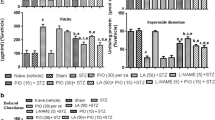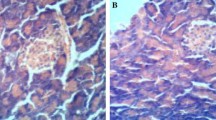Summary.
In the present study we evaluated the possible role of nitric oxide (NO) in mediating neuronal damage in middle-aged rats after an i.c.v. injection of streptozotocin (STREP). An i.c.v. injection of STREP has been reported to decrease the central metabolism of glucose. This inhibition of the energy metabolism after STREP treatment might induce an excitotoxic mechanism, which may lead to the stimulation of NO synthase and, consequently to the synthesis of NO. On the other hand, STREP might induce oxidative stress directly by liberation of NO from its nitroso moiety. To investigate whether NO synthase is involved in a possible excitotoxic mechanism after STREP treatment, some of the rats treated with STREP (1.25 mg/kg in 4 μl, bilaterally 2 μl/injection site) were also treated with the NO synthase inhibitor N-nitro-l-arginine methyl ester (l-NAME, 20 mg/kg i.p. 10 min, 6, 24 and 96 h after STREP injection). To investigate whether NO liberated from STREP may be responsible for neurotoxic effects, one additional group of control rats received an i.c.v. injection of the NO donor sodium nitroprusside (SNP, 10 μg in 4 μl). We found that STREP affected the behavioral performances in the open field and two-way active avoidance task. In addition, immunostaining for glial fibrillary acidic protein, an indicator of reactive astroglial changes to neuronal damage, showed that this was mainly located in peri- and paraventricular regions of the third and lateral ventricles, like for instance in the septum, caudate putamen and hippocampus. l-NAME treatment had no protective effect on the behavioral impairments and neuronal damage of STREP-treated rats. This suggests that the neuronal damage of STREP may still be a result of the decrease in the central energy metabolism, but without the involvement of NO synthase. This was supported by measuring, using immunostaining, the NO-mediated cyclic GMP production by the enzyme soluble guanylyl cyclase in cortical slices, i.e. l-NAME did not prevent NO production after STREP administration in vitro. In addition, it was found that SNP liberated NO in vitro, whereas in vivo SNP administration did not lead to any behavioral and neuronal deficits at all. However, the present study cannot exclude the involvement of NO liberated from STREP in neuronal damage.
Similar content being viewed by others
Author information
Authors and Affiliations
Additional information
Received June 7, 1999; accepted September 30, 1999
Rights and permissions
About this article
Cite this article
Prickaerts, J., de Vente, J., Honig, W. et al. Nitric oxide synthase does not mediate neurotoxicity after an i.c.v. injection of streptozotocin in the rat. J Neural Transm 107, 745–766 (2000). https://doi.org/10.1007/s007020070056
Published:
Issue Date:
DOI: https://doi.org/10.1007/s007020070056




